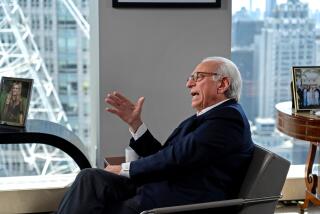The Thinking Behind IBM, and Why Viacom’s so Viable
Stock Exchange gives readers a chance to listen in as staff writers James Peltz and Michael Hiltzik debate the merits of individual stocks.
International Business Machines (IBM)
Jim: We start today with IBM, a.k.a. Big Blue, and I guess we need some disclosure first, right, partner?
Mike: Someone recently wrote an article about how journalists often disclose conflicts of interest just to brag. You know, like a guy saying he’d love to write about Walt Disney Co., but, gosh, he can’t because Disney’s just optioned his unwritten novel for a million bucks.
Jim: Somehow I don’t think you have that problem.
Mike: I wish. However, I would like to disclose that the one stock that I own outright, as opposed to investing in mutual funds, is IBM. And I think my investment says something about this whole question of buy-and-hold investing, and intestinal fortitude and my personal strength of character.
Jim: Keep going.
Mike: I bought 50 shares of IBM on Sept. 18, 1992, when the stock was selling for $83.75 a share.
Jim: A time when IBM was in big trouble.
Mike: It was. And one reason I bought the stock was that, with its price so historically low, IBM’s dividend had a tremendous yield of well over 9%. So I figured, with a yield like that, what could go wrong? So I bought my 50 shares, and IBM promptly cut the dividend by more than half.
Jim: What prescience! But you didn’t bail?
Mike: Nope. Hung on to that stock as onto a concrete life raft while it plunged to the low 40s. And I remember thinking: When I pass this stock on to my great-grandchildren, maybe it will be worth what I paid for it.
Jim: And sure enough, the stock has roared back.
Mike: So it has. In the intervening years, IBM split 2 for 1, so now I have 100 shares of a stock that’s trading around $167 a share, or $334 pre-split. Put another way: Over the six-plus years, I’ve made 25% a year with IBM if we include reinvested dividends. That’s versus 18.9% for our favorite benchmark, the Standard & Poor’s 500.
Jim: And the moral is?
Mike: That I should be paid a couple of million dollars a year for my investing judgment. Seriously, the point is that if you’re confident about a company’s ability to come back, and don’t panic, there’s nothing wrong with buying its stock when it’s out of favor with most everyone else.
Jim: Easier said than done.
Mike: I don’t deny that. But IBM finally got a management team, led by Chief Executive Louis Gerstner Jr., that’s done an amazing job turning IBM around.
Jim: Review for us how IBM got into such trouble in the late ‘80s and early ‘90s.
Mike: IBM, of course, was long the biggest maker of mainframe computers, those giant machines used by big businesses and governments. But a decade ago, it plunged into lots of other, emerging computer-related markets where it could not be No. 1, markets that were changing incredibly fast. IBM, with its stodgy management and stifling bureaucracy, couldn’t keep up with the rapid rate of technological and commercial changes.
Jim: It was a rude awakening not only for IBM, but for Wall Street.
Mike: No kidding. Remember the old saying that if you were a money manager, you could never get fired for buying IBM?
Jim: Big Blue was the premier blue chip.
Mike: But mainframes ceased being the center of everyone’s attention. We went to personal computers and workstations. Interestingly, while IBM brought out one of the first commercial PCs, and its architecture still dominates today, the company has not been able to dominate the PC market.
Jim: No, IBM has to share that market with the likes of Compaq, Dell and Gateway.
Mike: Look at it this way: IBM had dominated a vertically integrated world, meaning it did everything for the customer. It built the hardware, wrote the software, serviced the equipment, trained your employees to operate it, and thus theoretically locked the customer into its product line for generations to come.
Jim: And now?
Mike: Now the information-technology world, led by the PC, is horizontal. You can buy your components, software and services from a dozen different suppliers, because the parts in many ways are interchangeable. In fact, when IBM introduced the PC, it was, in a sense, writing the epitaph for its own business.
Jim: Until Gerstner came along. He’s a done an admirable job of cutting IBM’s fat, focusing its energies and reestablishing IBM as a major competitor. And it still is an enormous enterprise. It makes not only the big computers and PCs, but chips and data-storage devices, enterprise and consumer software, and offers an array of services. And it’s trying to get big in electronic commerce on the Internet--although what computer company isn’t?
Mike: Services, in fact, is one of its hottest groups.
Jim: But many of its hardware groups are not, and therein lies my problem with IBM. As a whole, the company’s growth is only in the single digits, and, even though it’s picked up somewhat in recent months, it’s still too weak.
Mike: What about its stock?
Jim: Because of the growth issues, and because IBM’s stock has already rallied so much--it’s up about 53% for the last 12 months alone--I wouldn’t buy it.
Mike: Well, I know you’ve held back until now so as not to hurt my feelings. But the truth is, I agree with you.
Jim: You’re going to sell your 100 shares?
Mike: No, sir. IBM is a stock that I’m delighted to have in my portfolio. But it’s hard to see where it’s going from here. I wouldn’t sell, nor would I recommend buying it at this price. This stock is at an all-time high, and yet every one of its main competitors is growing faster than it is.
Jim: The stock’s only trading at 25 times ’98 earnings, which is below the market’s multiple.
Mike: But IBM is also performing below the market. It’s going to take a while for IBM’s growth to catch up with the stock even at that price--even though I find Gerstner’s efforts very promising.
Viacom (VIA/B)
Jim: Any discussion of Viacom first requires a knowledge of “Rugrats,” does it not?
Mike: Yes, and we’re both qualified. We’re speaking, of course, about the hit cartoon on Viacom’s Nickelodeon cable channel for kids. Listening to the show makes my ears bleed, but I’ve got a fifth-grader and a second-grader, and I can vouch for its popularity.
Jim: For those living in a cave, Viacom also just released the first “Rugrats” movie in theaters. All it did was make $28 million on its opening weekend, beating all adult-oriented films at the box office--and it’s hung on at the multiplex against such stiff family-oriented fare as “A Bug’s Life.”
Mike: Supporting, in turn, all the “Rugrats” toys and other promotion paraphernalia that’s de rigueur with new movies these days. I wish I had the franchise on the “Rugrats” tchotchkes, because we seem to be getting a tremendous number of them in our house.
Jim: And “Rugrats” is just one reason Viacom’s on a roll. Check out the rest of its assets, which have been assembled by its seventysomething CEO, Sumner Redstone: Paramount Pictures, whose other recent movies have included “The Truman Show” and “Saving Private Ryan.”
Mike: Don’t forget the biggest one of all, “Titanic,” which it co-financed with Fox. And now it’s distributing the “Titanic” home video.
Jim: Paramount is among the studios known for financing or distributing many of its movies in partnership with others, with the profits and losses to be split accordingly.
Mike: So that Viacom’s risk is lower if the movie bombs, heaven forbid. Of course, its upside is limited too.
Jim: Then there’s Paramount TV, which produces such shows as “Frasier.” In cable, Viacom owns Nickelodeon, MTV and Showtime. Viacom also has a majority stake in Spelling Entertainment, which makes “Beverly Hills 90210” and “Melrose Place.”
Mike: And other rivals of “Masterpiece Theater.”
Jim: Plus it owns Blockbuster Video, which has enjoyed a huge resurgence from a few years ago when its prospects were as lousy as most of the films it rents. Finally, it also owns a bunch of TV stations and theme parks.
Mike: Usually when we talk about entertainment companies with their hands in all these areas, the next line you hear is: “Why aren’t any of them doing well?” But you won’t hear that about Viacom, because just about everything it owns is beating expectations.
Jim: Viacom, in fact, is probably the one entertainment challenger to Disney in terms of knowing how to use all its divisions--movies, TV, music--to wring every last dime out of a single product.
Mike: Yep, “Rugrats” is just hitting the theaters, then it will hit Paramount’s home-video division and then it will be rented through Blockbuster.
Jim: Which makes it all the more interesting that Viacom is now talking about splitting itself up, so to speak. It’s already sold most of its Simon & Schuster publishing house for more than $4 billion. It’s all but said Blockbuster might soon get spun off, and it’s talking about divesting its Spelling Entertainment stake, at least someday.
Mike: Which is one reason I’d buy this stock. Redstone is one wily billionaire, and he knows he’s dangling these properties while they’re performing well and drawing a very receptive market of potential buyers. We can count on his getting the absolute best price for them.
Jim: In the meantime, the existing Viacom is growing at a double-digit clip. That growth, and the expectations of the asset sales, are why Viacom’s stock has doubled in price over the last 12 months, to the $67-$68 range.
Mike: We should note that Viacom has two classes of stock, A and B, with the nonvoting B shares being the more widely traded. But they virtually track each other.
Jim: Right. And one other notable factoid about Viacom is that it’s one of the few glamour entertainment stocks listed on the American Stock Exchange.
Mike: And one now selling for 160 times earnings.
Jim: Which, as you know, normally turns me off. But this company and this stock have lots of momentum. The company is churning out above-market growth. The asset sales are coming. Redstone is one of the industry’s most respected chieftains.
Mike: Agreed. There’s plenty of pop left in these shares, but you need to watch any company in the entertainment field like a hawk, because its ability to make money could end at any time.
*
Do you have a stock you would like to see discussed in this column? Michael Hiltzik can be reached at michael.hiltzik@latimes.com; James Peltz can be reached at james.peltz@latimes.com. Or write to either at Business Section, Times Mirror Square, Los Angeles, CA 90053.
More to Read
Inside the business of entertainment
The Wide Shot brings you news, analysis and insights on everything from streaming wars to production — and what it all means for the future.
You may occasionally receive promotional content from the Los Angeles Times.











